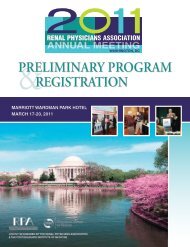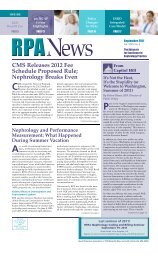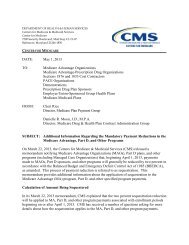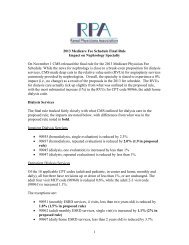The RPA Health Policy Handbook - Renal Physicians Association
The RPA Health Policy Handbook - Renal Physicians Association
The RPA Health Policy Handbook - Renal Physicians Association
Create successful ePaper yourself
Turn your PDF publications into a flip-book with our unique Google optimized e-Paper software.
T H e a D V o C a T e f o R e X C e l l e n C e I n n e P H R o l o G Y P R a C T I C e<br />
subcommittee will hold public hearings, either in Washington, DC or some other region of<br />
the country, where constituents may ask to present their positions.<br />
If your Senator or Representative is not on the relevant subcommittee, does that mean you<br />
have no influence over the outcome? No. It is true that members of a subcommittee are<br />
regarded as “specialists” by their colleagues and therefore, can wield considerable power in<br />
deciding whether or not an issue will be advanced through the legislative process. However,<br />
your own Senators and Representatives, whether or not they are on the subcommittee, can<br />
often be effective intermediaries, depending on their personal or political relationships with<br />
the subcommittee members. <strong>The</strong> more a legislator hears from his non-Committee colleague<br />
on one side or the other of an issue can determine its ultimate resolution.<br />
See APPENDIX B for Key Congressional Committees on <strong>Health</strong>care issues.<br />
floor Action<br />
Once a committee has approved legislation, it becomes eligible for debate on the House and<br />
Senate floors, where it may be passed, defeated, or amended. Since floor debates are often<br />
scheduled on short notice, messages (e-mails, calls, letters) should be prepared well in<br />
advance. However, keep in mind that timing is extremely critical. Any communications about<br />
legislation that is coming up for a floor debate should arrive as close to the time of voting as<br />
possible. <strong>RPA</strong> monitors the timing of these activities and seeks to keep <strong>RPA</strong> grassroots<br />
members as informed as possible in advance of relevant floor action by sending out e-mail<br />
alerts to grassroots volunteers.<br />
Conference Committee<br />
In most instances the House and Senate pass different versions of the same bill. When that<br />
occurs, a handful of members from each chamber are appointed to serve on a conference<br />
committee, where they attempt to work out a compromise. Representation on the conference<br />
committee will usually consist of selected members of the House and Senate subcommittees<br />
that originally developed the legislation. In some instances, conference committees may only<br />
need to resolve a few issues. Constituents whose Senators or Representatives happen to be on<br />
a conference committee can play a crucial role in the deliberations.<br />
<strong>The</strong> end product of the meetings is a conference report containing the compromise bill and a<br />
section-by-section explanation of the compromise that was agreed upon. Once both the<br />
House and Senate agree to the conference report, the measure is sent to the President for<br />
approval (or veto).<br />
Leadership Structure<br />
Understanding the leadership structure in Congress is just as important as understanding the<br />
committee process. <strong>The</strong> leadership ultimately decides when and how bills are considered for<br />
passage. It has become more commonplace for the leadership in both chambers to bypass the<br />
committee process and bring legislation directly to the floor for debate and passage.<br />
See APPENDIX C for the Senate and House leadership structures.<br />
health policy handbook for nephrology practitioners<br />
CHaPTeR 5<br />
19












